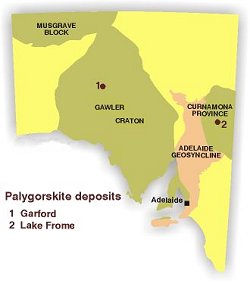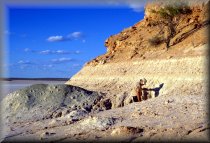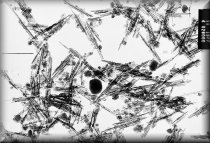 Palygorskite is a rare, fibrous clay (Mg2Al2Si8O20(OH)2(OH2)4M+.(H2O)4) which is also known as Attapulgite or fuller’s earth. Commercial deposits form under alkaline conditions in inland lakes or closed marginal marine basins. Small deposits are also associated with hydrothermal alteration of magnesium-rich rocks. The fibrous nature of palygorskite gives the clay a high surface area and porosity which provide excellent sorption and gelling properties. The major uses of palygorskite are as absorbent granules and powders, mostly for pet litter markets and general industrial absorbents. Significant quantities are used in animal feeds, drilling mud (especially in saline water), clarifying agent, as a pesticide carrier, suspending agent for liquid fertiliser, and as a thickener in water and organic-based systems. New markets in environmental clean up, waste management and catalysts are being developed.
Palygorskite is a rare, fibrous clay (Mg2Al2Si8O20(OH)2(OH2)4M+.(H2O)4) which is also known as Attapulgite or fuller’s earth. Commercial deposits form under alkaline conditions in inland lakes or closed marginal marine basins. Small deposits are also associated with hydrothermal alteration of magnesium-rich rocks. The fibrous nature of palygorskite gives the clay a high surface area and porosity which provide excellent sorption and gelling properties. The major uses of palygorskite are as absorbent granules and powders, mostly for pet litter markets and general industrial absorbents. Significant quantities are used in animal feeds, drilling mud (especially in saline water), clarifying agent, as a pesticide carrier, suspending agent for liquid fertiliser, and as a thickener in water and organic-based systems. New markets in environmental clean up, waste management and catalysts are being developed.
Backhoe trench in Garford Formation pale dolomitic clay below gypsum dune sand at PB Lake, Garford Palaeochannel. | Around 80% of the world’s production of 1 Mt/year of palygorskite comes from deposits in the Attapulgus–Quincy district in the United States. The Australian production of 20 000 t/year comes from Lake Nerramyne, 400 km north of Perth, Western Australia. In inland Australia, palygorskite is widely associated with clay and carbonate sediments in river channel and lake deposits of late Tertiary age. Drilling in the Garford Palaeochannel, 720 km northwest of Adelaide, identified intersections of commercial grades of palygorskite up to 2 m thick over an 18 km length of the palaeochannel (Fig.1 and Fig. 2). Similar sediments have been reported from the Lake Frome area. Small deposits of pedogenic palygorskite are associated with weathered dolomitic sediments in the Mount Grainger Diapir, 8 km north of Oodla Wirra. |
TEM photomicrograph of palygorskite from Paly Lake, Garford Palaeochannel. The scale bar represents 0.5 µm. | Additional readingBarnes, L.C., Olliver, J.G. and Spencer, W.G., 1980. Reconnaissance sampling of palygorskite deposits, Lake Frome area, South Australia. Mineral Resources Review, South Australia, 149:22-31. Keeling, J.L., Ferris, G.M. and Statham-Lee, L., 1995. Palygorskite clay investigation, Garford Palaeochannel, South Australia: results of drilling April–May 1995. South Australia. Department of Mines and Energy. Report Book, 95/48. Keeling J.L. and Self, P.G., 1996. Garford palaeochannel palygorskite. MESA Journal, 1:20-23. |




